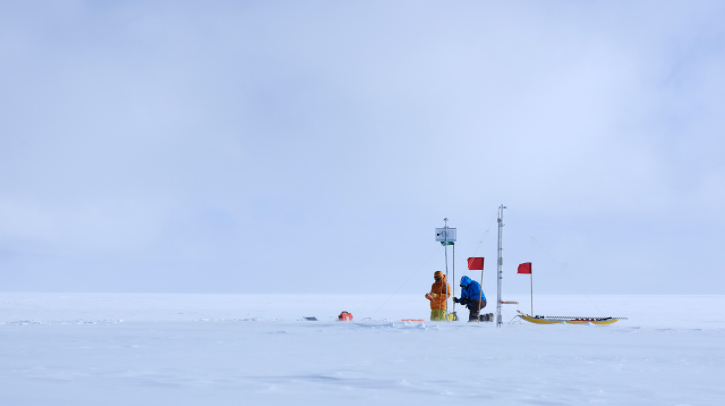Construction is set to begin on an automated and mobile polar observatory to bridge air-ice observational gaps and lay the groundwork for an early warning system for ice sheet melt in some of the most remote and under-sampled regions of the Arctic.
The observatory will measure meteorological conditions, such as temperature near the ice surface, humidity, winds, turbulence, cloud information, precipitation, pressure and solar radiation. A specially developed optical sensor, fitted to an ice-phobic-coated and insulated drone, will enable the researchers to observe the properties of climate-important clouds up to 4km above the ice sheet. Alongside this, the observatory will have a range of visual photogrammetry and infrared camera technology, which will survey accumulated snow, ice surface roughness, ice sheet velocity, ice sheet surface melting and air-to-ice heat transfer, and keep a check on the general conditions and health of the instruments.
The observatory is the brainchild of a team at the National Centre for Atmospheric Science (NCAS), the University of Colorado Boulder, Menapia and Polar Field Services. By leveraging advancements in renewable energy, remote-sensing and in-situ instruments, automated aerial robotics, satellite communications and machine learning (ML), the brand-new Arctic-hardened and self-sustaining modular observatory will be designed and built in 2025.
International collaboration
NCAS’s new Arctic observatory forms part of the GAMB2LE project, which in turn is part of the Advanced Research + Invention Agency‘s (ARIA) £81m (US$102m) Forecasting Tipping Points program. Co-led by program directors Gemma Bale and Sarah Bohndiek, the Forecasting Tipping Points program looks to create an early warning system capable of equipping the world with the information, understanding and time needed to accelerate proactive climate adaptation and mitigation. It will unite 27 international teams in a collaborative effort to detect the earliest signs of climate tipping points.
ARIA is sponsored by the UK’s Department for Science, Innovation, and Technology.
Breaking barriers in Arctic science
Until now, researchers have had to overcome logistical challenges, extreme weather and reliance on low-powered and basic weather stations, which often lack the means to make all the precise atmospheric and ice measurements they require – or extremely resource-intensive manned research stations.
Dr Ryan Neely, associate professor of observational atmospheric science at NCAS and the University of Leeds, said, “As climate change accelerates, the need for innovative and adaptive scientific solutions has never been greater. We’re at the forefront of this effort, creating an observatory ‘in a box’ that’ll equip researchers with the tools necessary to identify critical tipping points in Greenland’s ice loss trajectory.”
Dr Michael Gallagher, researcher with the Cooperative Institute for Research in Environmental Sciences (CIRES) at the University of Colorado Boulder, explained how the new observatory “in a box” will bring bigger impacts from a modest setup: “We are shooting for the data quality and quantity of a large research station, but with a fraction of the footprint and resource requirements, and the deployability akin to that of a much smaller weather station.”
Focusing on the atmosphere-ice interface, the new observatory will be optimized to continuously collect high-resolution data in even the most challenging cold environments – redefining how scientists observe and understand the climate tipping points of the Greenland ice sheet.
Understanding a rapidly changing environment
According to the researchers, ice loss from Greenland is the single-largest contributor to global sea level rise, followed by ocean thermal expansion. The freshwater influx from the melting ice sheet also has the potential to disrupt ocean currents and marine ecosystems, influencing climate patterns on a global scale.
Dr Sarah Barr, NCAS meteorology researcher at the University of Manchester and University of Leeds, said, “To better predict and mitigate the impacts of ice loss, we are developing a way to get a deeper understanding of the physical processes governing the exchange of energy and mass between the Greenland ice sheet and the atmosphere.”
Testing the limits – from Iceland to Greenland
Before full-scale deployment in Greenland, the team will conduct operational trials of the mobile and modular observatory in Iceland. Testing the performance of the Arctic-hardened automated drones and the miniaturized ground-based instruments will be the priority, making sure the system is refined and resilient for even harsher environments.
Dr Heather Guy, Research Fellow in polar observational meteorology at NCAS and the University of Leeds, said, “The long-term plan will be to establish a new benchmark for automated polar research, deploy the observatory across previously inaccessible regions of the Greenland ice sheet, and deliver vital insights that will shape global climate strategies for years to come.”
In related news, researchers from the College of Engineering and Computer Science at Florida Atlantic University (FAU) recently proposed a design of an autonomous observational method for monitoring melting Arctic sea ice. Click here to read the full story.



